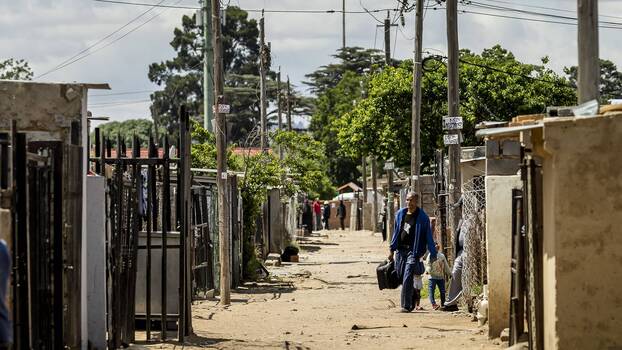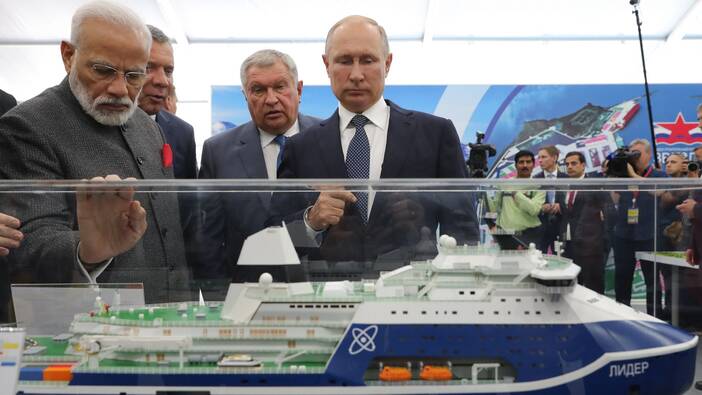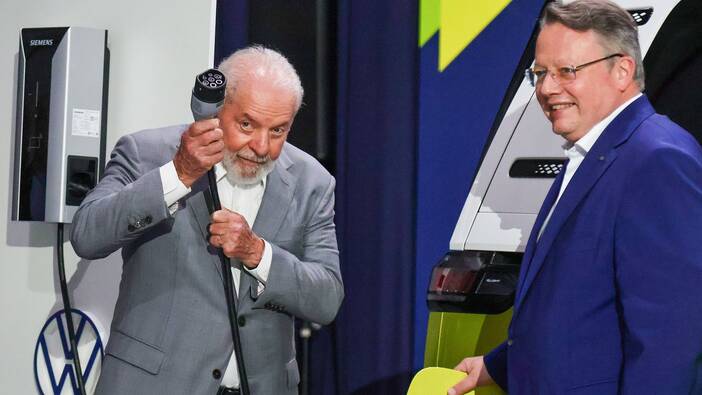
This year, 30 years since the dismantling of apartheid, South Africa faces its seventh round of democratic elections on 29 May. The tension and nervousness are already palpable.
Janine Walter directs the Rosa Luxemburg Foundation’s Johannesburg Office.
The first free election campaign in 1994 was already characterized by tensions and violence — but also by a great deal of hope. The images of endless queues outside polling stations — a powerful symbol of the victory of humanity over colonial crimes — have not been forgotten. The African National Congress (ANC) swept up 62 percent of the vote and has since governed in a three-way arrangement — the Tripartite Alliance — together with the Congress of South African Trade Unions (COSATU) and the South African Communist Party (SACP).
Back then, many in South Africa and far beyond had high hopes for the transformation of the country in the wake of apartheid. But today, considering the country’s desperate economic situation and the opportunism displayed by numerous former beacons of hope, all that euphoria has evaporated. Given daily electricity rationing, dilapidated infrastructure, and exploding crime rates, the bulk of the population is dissatisfied. Alongside corruption — exemplified by the state capture scandal, which revealed illicit links between political and economic elites — the most urgent challenge remains economic liberation. This is because South Africa is characterized by a stagnating economy, high levels of unemployment, and growing poverty rates.
South African Capitalism Post-Apartheid
In the period immediately following the end of apartheid, there was a clear focus on the development of a strategy for economic policy. The South African government made the satisfaction of the basic needs of the population its top priority, for example through large-scale housing construction programmes and the expansion of the electricity network. But as early as 1996, the government — still headed by Nelson Mandela — pivoted to a neoliberal approach to seeking growth and reducing the budget deficit. This included the flexibilization of the labour market and the privatization of parts of the public sector. As a result, social policy receded into the background.
The rationale for this change of economic tack was that it would attract foreign capital. This was especially necessary for the mining sector, which is oriented towards foreign trade and has traditionally possessed a pre-eminent relevance for South Africa’s economy. Even if the sector has declined in importance, to the point where it now only represents eight percent of the country’s gross domestic product (GDP), mining remains an important pillar of South Africa’s economy. The concept of the “mineral energy complex”, developed by Ben Fine and Zavareh Rustomjee, describes the close intertwining of the mining, energy, and finance sectors, a state of affairs that continues to this day. It is no accident that the state electricity corporation ESKOM has been at the centre of the state capture scandal.
The traditional trade unions hardly gave any attention to the steadily growing proportion of precariously employed workers.
After 1994, it was not only the finance sector and the telecommunications industry that gained in importance, but also retail, which has come to represent almost 20 percent of GDP. South African chains now dominate almost the entirety of the continent’s rapidly expanding formal retail sector. South African factions of capital use this regional integration to expand and safeguard their economic interests.
An important role has been played in all of this by the New Partnership for Africa’s Development (NEPAD), proclaimed in October 2001 by the leaders of 15 African countries. The idea for this neoliberal reform initiative can be traced back to South African President Thabo Mbeki, whose foreign policy vision aimed at an “African renaissance”. Pretoria used NEPAD, which was established without any consultation with civil society or trade unions, to strengthen its position as regional hegemon. This “new elite pact” initiated processes of flexibilization and liberalization in many parts of Africa, opening up new business opportunities for South African companies. Besides mining corporations such as Anglogold Ashanti or telecommunications firms like MTN or Vodacom, it was particularly retail companies such as Shoprite and Pick n Pay that were able to expand their operations on a massive scale.
On the surface, the results of the new orientation in economic policy seemed to prove their advocates right, since in the following two decades the South African economy did indeed achieve average economic growth rates of three percent. However, integrating the economy into the global economic order only took place at the expense of the socio-economic redistribution that would have been necessary to overcome the inequalities resulting from apartheid. As measured by the Gini coefficient, South Africa now has the highest income inequality in the world; 64 percent of the Black population live below the poverty line.
Exploding Precarity and the Trade Union Struggle
During apartheid, it was not least of all the trade unions who combined the fight against exploitation with the fight for democratization and social development. One result of this struggle was the close ties between the ANC, the SACP, and the majority of South Africa’s trade unions, which ultimately found expression in the Tripartite Alliance.
Considering the prominent role of the unions, high hopes were pinned on post-apartheid governments. Many looked for an inclusive, participative labour regime. In the process of transition, COSATU played an important role in shaping the new social order, and was instrumental in shaping economic policy according to the principle of “growth through redistribution”. By contrast, the ANC was quick to follow the lead of capitalist interests, both domestic and foreign, by supporting an export-oriented growth strategy and welcoming proposals for privatization schemes. By the mid-1990s, most unions had bowed to the neoliberal credo. In return, they were permitted a degree of influence within a corporatist system of labour relations oriented around social partnership.
With this step, the unions opened the door for the flexibilization and fragmentation of the employment world. This process led to a rapid increase in precarious conditions of employment. It was to prove to be a key factor in South Africa’s economic growth. What followed was the division of the labour market into a core of relatively well-protected workers and the mass of the precariously or informally employed and the jobless. The economic hopes that had been linked to democratization were dashed.
One thing is clear: the ANC can no longer rely on the aura it acquired as a liberation movement.
As a result, the full-time employment rate among the working population fell by 20 percent between 1995 and 2001, while informal employment rose from 17 to 31 percent. While in 1995 temporary employment agencies employed around 100,000 people, by 2014 that figure had risen to 2.2 million. The wholesale and retail sectors have been particularly affected, with one third of employees precariously employed. The development has meant the continued existence of mass working poverty — a structural characteristic of apartheid.
However, the traditional trade unions — which are also numerically the strongest — hardly gave any attention to the steadily growing proportion of precariously employed workers. Since 2000, the COSATU leadership has tended rather to shift its engagement from the private sector, where precarious employment is concentrated, to the public sector, in which the confederation was seeing a sharp membership increase. This turn from mass mobilization towards an institutionalization of the unions illustrates the gap that has opened up between the leadership and the base.
There have also been massive discrepancies between rhetoric and reality in the case of the third partner in the Tripartite Alliance, the SACP. The radical speeches at their party congresses stand in sharp contrast to the privatization and austerity programmes for which ministers from the SACP have been co-responsible. The party has therefore seen internal debates over its future — with proposals ranging from a left-wing electoral front outside the ANC to a reconfiguration of the Tripartite Alliance. Nonetheless, the SACP is expected to contest the elections in cooperation with the ANC again — and to then resume the discussion once more over whether such an approach will remain sustainable at the next elections in 2026.
An End to the ANC’s Dominance
One thing is clear: the ANC can no longer rely on the aura it acquired as a liberation movement. The same goes for its partners in the Tripartite Alliance, as a large section of the population blames the country’s ongoing economic distress on the failures of political decision-makers. This is putting a party that has now ruled for 30 years under increasing pressure; at the upcoming elections, the ANC risks losing its majority for the first time.
Opposition parties on the left and the right of the ANC are ready and raring to go. Right of the ANC, seven very different parties have already positioned themselves with a “Multi-Party Charter”. The alliance is led by the largest opposition party, the Democratic Alliance (DA).
Left of the ANC are the Economic Freedom Fighters (EFF), a party that should certainly be viewed with a degree of scepticism. It is true that they are advocating for comprehensive land reform and the nationalization of the still-crucial mining sector. At the same time, the party is strongly geared towards its leader, and party members have been frequently noted for their hate speech directed at white South Africans and South Africans of Indian descent. Moreover, former president Jacob Zuma, who still enjoys widespread approval in his home province of KwaZulu-Natal, recently declared his support for the newly founded party uMkhonto weSizwe, named after the military arm of the ANC.
Meanwhile, the ANC is caught up in factional struggles between the circle around incumbent President Cyril Ramaphosa and the more radical faction centred on Vice-President Paul Mashatile. If the party loses its absolute majority, South Africa will be faced with the prospect of a coalition government for the first time. While the faction around Mashatile prefers a coalition with the EFF, the Ramaphosa faction tends to look towards the DA as a potential partner. One thing is certain: the ANC is facing difficult times — but where they will lead is still an open question.
Translated by Marc Hiatt and Ryan Eyers for Gegensatz Translation Collective.

